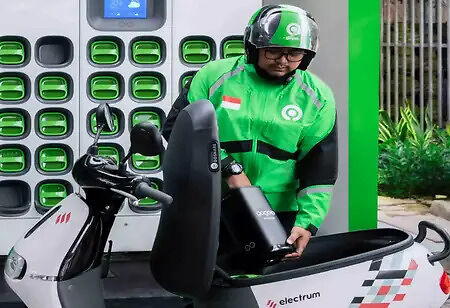
Will the Battery Swapping Policy Increase EV Adoption in India?


India is the fourth significant emitter of greenhouse gasses in the world, contributing 7.08 percent of all global emissions. The country’s vision of achieving net-zero emissions by 2070 would be challenging, but it is not impossible. While speaking at the COP26 summit, Prime Minister Narendra Modi ascertained that India aims to achieve net-zero emissions by 2070.
India is growing in population as well as in economy. This leads more people to depend on vehicles. According to reports, India is in the third position in emitting CO2, wherein road transport computes about 90 percent of total CO2 emissions. The greenhouse gas emission in India consists of 70 percent CO2 and 30 Percent non-CO2 emissions. With the economic development in India, the vehicle ownership level has increased to 0.4 percent for two-wheelers and 11 percent for cars from 2001 to 2015. Quantification of the emission should be done frequently through the policies. The road transport sector has implemented the fleet characteristics about the vehicle's age.
Adoption of Electric vehicles (EV) is the way to reduce carbon emissions in the country. Our government has undertaken several initiatives, including the Faster Adoption and Manufacturing of (Hybrid) Electric Vehicles in India (FAME) I & II schemes, as well as a Production Linked Incentive (PLI) Scheme for the National Program on Advanced Chemistry Cell (ACC) Battery Storage (NPACC) to boost domestic manufacturing of batteries. Even the government is looking for other methods to boost the adoption of EVs in India. Usually, EVs are built with fixed batteries that are charged by plugging the vehicles into the charging point. Still, the batteries will be inside the vehicle. To make EV operations smoother, charging facilities should be increased all over the country.
Another easy and beneficial way of adopting the EV is battery swapping services, which makes the charging process more efficient, faster, and cheaper way to charge the battery. Especially in our country, we have smaller and simpler batteries for two and three-wheelers, which makes the charging easy. To build and optimize the battery swapping ecosystems and pave the path towards large-scale EV adoption in India, our government has created a new policy introducing a draft battery swapping policy and interoperability standards.
Battery Compatibility with Consistency
When it comes to consistency, it depends on transferring batteries from one ecosystem to another. The different ecosystems would follow different chemistry and cell technology to operate the batteries, even if the policy comes into effect. There would be a particular battery pack dimension, and the infrastructure deployed might support a specific ecosystem. Even it depends on the life cycle of the battery too. When interoperability between ecosystems is enforced, it might lead to instances where an end-of-life battery gets swapped with a brand-new battery. Considering these challenges, inter-operable ecosystems are not a feasible option.
Regarding phased transition, the battery companies have already made significant investments in batteries and connectors before any standardization measures kick in. Since ACC batteries have a much longer life, this transition period has to be very long. There should be an additional systematic incentive and support for the providers to undertake the transition to an interoperable ecosystem.
Data Transfer
Data is the major service differentiator. Based on the operations and financials, the battery provider optimizes the battery data assets. The right thing to do is to find out whether there is a specific thing that the government considers important for enhancing customer experience. The data should be submitted in a predefined format on a quarterly basis as self-declaration by the battery provider and come into effect for the providers opting for interoperability between ecosystems. Through this, the providers will lose their competitive edge over their peers, and it would discourage innovation in the industry.
Business Models
EV adoption will increase in India by eliminating and avoiding closed loops. The battery swapping policy in India aims to standardize and achieve compatibility of EVs, batteries, and charging infrastructure. Besides, interoperability between BSS ecosystems will not be allowed. There must be minimal mandatory data sharing by the battery providers and only for the purpose of benefiting the end-users. The need of the hour is to create a safe, reliable, and compatible ecosystem with standardization that can help the industry and boost EV adoption in the country.
Standardization and the business models might allow batteries to be compatible with different sets of EVs and be cross-utilized. Therefore, the kWh rating must be considered as the basis for fiscal incentives. Government should create a level playing field and encourage early adopters. This can be done by the fiscal benefit being equally passed on to the existing battery providers.
The end-user should also benefit from the incentive provided by lowering prices right from the outset. When we talk about the consequences, in the scenario of FAME-II Subsidy, it is not returnable by the EV OEM even if there is a complaint by the owner. Facing such problems would mean that the battery owners wouldn’t be able to pass the complete incentive to end-users and would be compelled to reserve part of the incentive as a hedge against complaint risks and reversal of incentive. Hence, such an issue would deny the complete benefit of the applicable incentive for the end-users.
Reports suggest that the Government of India is releasing a battery swapping policy later this month, and it won’t immediately introduce standardized batteries for swap stations, as it would need close coordination among swapping-point operators, but that will be the long-term goal.